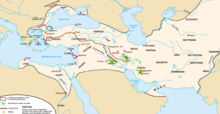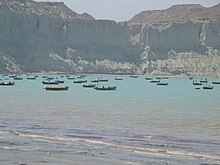Makran: Difference between revisions
No edit summary |
No edit summary |
||
| Line 1: | Line 1: | ||
The present day '''Makran''' ({{lang-fa|{{Nastaliq|مکران}}}}) (pronounced ''makkuraan'') is a semi-desert coastal strip in the south of [[Sindh]], [[Balochistan (Pakistan)|Balochistan]], in [[Iran]] and [[Pakistan]], along the coast of the [[Arabian Sea]] and the [[Gulf of Oman]]. The present day Makran derived its name from [[Maka(satrapy)|Maka]], a [[satrap]] of [[Achaemenid Empire]]. |
|||
==Achaemenid era== |
==Achaemenid era== |
||
Revision as of 10:35, 20 January 2012
The present day Makran (Template:Lang-fa) (pronounced makkuraan) is a semi-desert coastal strip in the south of Sindh, Balochistan, in Iran and Pakistan, along the coast of the Arabian Sea and the Gulf of Oman. The present day Makran derived its name from Maka, a satrap of Achaemenid Empire.
Achaemenid era
Maka was an important early eastern satrapy of Cyrus the Great, founder of the Achaemenid Empire. Makra corresponds to modern day Bahrain, Qatar, and United Arab Emirates, plus the northern half of Oman as well as Balochistan and the Sindh province of Pakistan.[1]Cyrus the Great united several ancient Iranian tribes to create an empire.

The word Maka later became Makran as it is common in closely related ancient Avestan and Old Persian languages to use "an" and "ran" at the end of plurals.[2] The Babylonians had also made voyages using Maka to communicate with India.[3] After Cyrus' death Darius I of Persia succeeded his throne. According to Greek historian Herodotus, Darius wanted to know more about Asia. He wished to know where the "Indus (which is the only river save one that produces crocodiles) emptied itself into the sea".[1] After personally leading his elite forces, whose ranks were restricted to those with Persian, Mede or Elamite ancestry, to fight the invading Scythians, he led another conquest towards Indian sub-continent.[4][5][6] where he conquered Sindh in 519 BC and constituted it as his 20th Satrapy and made use of the ocean there.[7][8] After the fall of Achaemenid Empire, Alexander also used Maka during his conquest and marched through a harsh desert path in Makran where he lost a significant number of soldiers but did not come across any Baluch force during his conquest except some coastal inhabitants. The harsh desert path is often mistaken as the whole of Makran region. Herodotus on several occasions mentions the contribution of "Mykian" that inhabited the eastern portion of the Achaemenid empire.[9] They are mentioned as "the men from Maka" in daiva inscriptions. The "Daiva inscription" is one of the most important of all Achaemenid inscriptions. They also took part in army of Xerxes the great at the battle of Thermopylae. The Mykians are also thought to be responsible for many inventions like qanats and underground drainage galleries that bring water from an aquifer on the piedmont to the gardens or palm groves on the plains. These inventions were very important reasons behind the success of the empire. The Mykians of the other side of ancient Maka, the present day region of Balochistan and Sindh had later taken independence because they are not mentioned in the book written by Arrian of Nicomedia about campaigns of Alexander the great but he only mentions the Oman side of Maka which he calls "Maketa". The reasons for this may have been the arguably unjust rule of Xerxes.[10][10][11]

Buddhism and Hinduism in the seventh century
Further evidence in the Chachnama makes perfectly clear that many areas of Makran as of Sindh had a largely Buddhist population . When Chach marched to Armabil , this town is described as having been in the hands of a Buddhist Samani (Samani Budda) a descendent of the agents of Rai Sahiras who had been elevated for their loyalty and devotion, but who later made themselves independent. The Buddhist chief offered his alligience to Chach when the latter was on his way to Kirman in 631 .The same chiefdom of Armadil is referred to by Huen Tsang 0-Tien -p-o-chi-lo, located at the high road running through Makran , and he also describes it as predominantly Buddhist , thinly populated though it was , it had no less than 80 Buddhist convents with about 5000 monks . In effect at eighteen km north west of Las Bela at Gandakahar , near the ruins of an ancient town are the caves of Gondrani , and as their constructions show these caves were undoubtedly Buddhist .Traveling through the Kij valley further west (then under the government of Persia) Huien Tsang saw some 100 Buddhist monasteries and 6000 priests . He also saw several hundred Deva temples in this part of Makran , and in the town of Su-nu li-chi-shi-fa-lo-which is probably Qasrqand- he saw a temple of Maheshvara Deva , richly adorned and sculptured . There is thus very wide extension of Indian cultural forms in Makran in the seventh century , even in the period when it fell under Persian sovereignty . By comparison in more recent times the last place of Hindu pilgrimage in Makran was Hinglaj, 256 km west of present day Karachi in Las Bela.[12]
The Historian Andre Wink has recorded Hiuen Tsang's notings on the language and script in use in Makran .
Hiuen Tsang considered the script which was in use in Makran to be 'much the same as India', but the spoken language 'differed a little from that of India[13]
Mahmud Ghazni
Baloch raiders plundered Mahmud of Ghaznis ambassador between Tabbas and Khabis and in revenge his son Masud defeated them at the latter place ,which lies at the foot of the Karman Mountains on the edge of the desert[14]
This section needs expansion. You can help by adding to it. (November 2011) |
Modern era
The narrow coastal plain rises very rapidly into several mountain ranges. Of the 1,000 km coastline, about 750 km is in Pakistan. The climate is very dry with very little rainfall. Makran is very sparsely inhabited, with much of the population being concentrated in a string of small ports including Chabahar, Gwatar, Jiwani, Gwadar (not to be confused with Gwatar), Pasni, Ormara and many smaller fishing villages.

The coast of Makran possesses only one island, Astola Island, near Pasni, and several insignificant islets. The coastline can be divided into an eastern lagoon coastline and a western embayed coastline. The main lagoons are Miani Hor and Kalamat Hor. The main bays of the embayed coast are Gwadar West Bay and Gwatar Bay. This latter bay shelters a large mangrove forest and the nesting grounds of endangered turtle species.
From the 15th century onward, the area was ruled by the Rind (tribe) which was headed by Mir Chakar Rind. In the late 18th century, the Khan of Kalat is said to have granted sanctuary at Gwadar to one of the claimants for the throne of Muscat. When that claimant became Sultan, he kept hold of Gwadar, installing a governor, who eventually led an army to conquer the city of Chabahar some 200 kilometres to the west.
The sultanate held onto the Makran coast throughout the period of British colonial rule, but eventually only Gwadar was left in the hands of the sultan. On the independence of Pakistan, Makran became a district within the province of Balochistan, minus an area of 800 km² around Gwadar. The enclave was finally transferred in 1958 to Pakistani control as part of the district of Makran. The entire region has been subdivided into new smaller districts over the years.
See also
- Gwadar
- 1945 Balochistan earthquake
- Makran Coastal Highway
- Makran Division
- Sokhta Koh
- State of Makran
- Lyari Town
- Khor Kalmat
External links
- Nicolini, Beatrice, The Makran-Baluch-African Network in Zanzibar and East Africa during the XIXth Century, African and Asian Studies, Volume 5, Numbers 3-4, 2006 , pp. 347–370(24)
- Al-Hind: Early Medieval India and the Expansion of Islam 7Th-11th
Notes
- ^ a b "History of Herodotus by Herodotus - Massachusetts Institute of Technology (MIT)". mit.edu. Retrieved 2010-09-11.
- ^ "Iranians and Turanians in Avesta". Ali A. Jafarey. accessdate=2010-09-10.
{{cite web}}: Check date values in:|date=(help); Missing pipe in:|date=(help) - ^ "The history of antiquity". Max Duncker. accessdate=2010-09-10.
{{cite web}}: Check date values in:|date=(help); Missing pipe in:|date=(help) - ^ "Persia". Angelfire.com. accessdate=2010-09-09.
{{cite web}}: Check date values in:|date=(help); Missing pipe in:|date=(help) - ^ "Iranian Provinces: Sistan and Baluchistan". Iranchamber.com. accessdate=2010-09-07.
{{cite web}}: Check date values in:|date=(help); Missing pipe in:|date=(help) - ^ "Ancient Persia". Ancientpersia.com. accessdate=2010-09-09.
{{cite web}}: Check date values in:|date=(help); Missing pipe in:|date=(help) - ^ "Darius the great". mdc.edu. accessdate=2010-09-10.
{{cite web}}: Check date values in:|date=(help); Missing pipe in:|date=(help) - ^ "The largest empire in ancient history". axehd.com. accessdate=2010-09-10.
{{cite web}}: Check date values in:|date=(help); Missing pipe in:|date=(help) - ^ "Full Text of Herodotus, Book 7,8 and 9". archive.org. accessdate=2010-10-02.
{{cite web}}: Check date values in:|date=(help); Missing pipe in:|date=(help) - ^ a b "The History, by Herodotus (book7)". cadelaide.edu.au. accessdate=2010-09-07.
{{cite web}}: Check date values in:|date=(help); Missing pipe in:|date=(help) - ^ "Maka". livius.org. accessdate=2010-10-1.
{{cite web}}: Check date values in:|date=(help); Missing pipe in:|date=(help) - ^ Al-Hind: Early medieval India and the expansion of Islam, 7th-11th centuries By André Wink page 135
- ^ Al-Hind: Early medieval India and the expansion of Islam, 7th-11th centuries By André Wink Page 137
- ^ Denzil Ibbetson, Edward MacLagan, H.A. Rose "A Glossary of The Tribes & Casts of The Punjab & North-West Frontier Province", 1911 AD, Page 43, Vol II,
